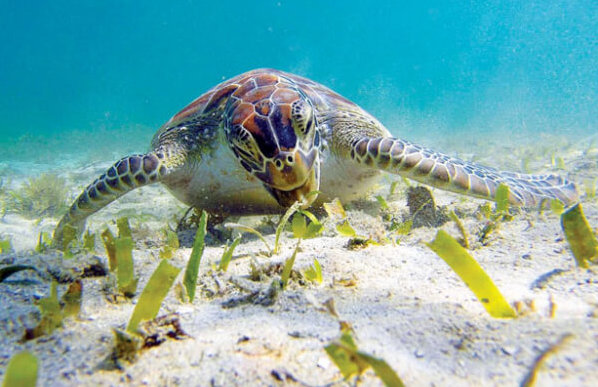
Tales from the 17th and 18th century tell of mariners finding so many sea turtles in the Caribbean that net fishing without snaring one of these beautiful beasts was all but impossible. No longer. Today, all sea turtles are considered either threatened or endangered by the U.S. Endangered Special Act. In the Caribbean, the four most common species are Leatherbacks, Green, Hawksbill and Loggerhead sea turtles. Many islands have active research and protection programs in place, as well as ways for the public to see these charming creatures up close and personal. Here’s a sampling of where and when:

St. Croix, U.S. Virgin Islands
The Sandy Point National Wildlife Refuge, located on the island’s far southwest corner, is where visitors and locals alike have enjoyed escorted evening tours to see Leatherback turtles for over two decades. On Tuesdays through Saturdays from April 1 to July 15, tour takers patrol the beach for females coming ashore to dig nests and lay eggs. On the same days of the week from June 16 to July 31, the focus shifts to watching for hatchlings to emerge from their nests and crawl to the sea. By day, there are interpretative signs that provide information about the turtles and the refuge itself. www.fws.gov/refuge/Sandy_Point/

St. Kitts & Nevis
Sea turtles nest year-round on the beaches of this two-island country. Specifically, Leatherbacks lay their eggs from February through July with hatchlings emerging through the end of September. Keys and North Friars are the primary Leatherback nesting beaches on St. Kitts. The nesting time for Hawksbills and Greens is March to December, with hatchlings sea bound though the end of February. These two smaller species can navigate rocky coastlines, so they favor the beaches on the Southeast Peninsula and the Caribbean side of the island, with occasional nests on the Atlantic side. “The St. Kitts Sea Turtle Monitoring Network (SKSTMN) offers two types of tours. One is the Leatherback Ecotour, offered from April 1 to June 1, where guests follow the research team on night patrols. The second is a tour with the In-Water Research Team on Sunday mornings, where participants participate in tagging juvenile sea turtles when captured offshore,” says director, Kimberly Stewart. The SKSTMN also offers its Sea Turtle Camp in July, for young people ages 9 to 16. www.stkittsturtles.org

Antigua & Barbuda
Hawksbill, Green, Leatherback and Loggerhead sea turtles are found in waters around these two islands. All but Loggerheads also nesting on the beaches. “The nesting season is from March to November,” says Nathan Wilson, of the Environmental Awareness Group (EAG), of which the Antigua Sea Turtle Project (ASTP) is part. “Occasionally green sea turtles can be spotted coming up for air in Freeman’s Bay, located in English Harbour. Hawksbill turtles tend to nest on Jumby Bay.” During the nesting season, the EAG hosts paid tours with one of the ASTP’s volunteer patrollers to give visitors an opportunity to see the turtles. www.eagantigua.org
Dominica
You’re never far from a potential sea turtle encounter on Dominica. Good spots to see Leatherbacks, Greens and Hawksbills nest are the southeast of the island around Rosalie Bay and to the northeast near Marigot, both between March and August. Greens and Hawksbills also nest on west coast beaches from May to October. “A great resource for turtle watching is the Dominica Sea Turtle Conservation Organization (DomSeTCO),” says Cyrilla Alexis, marketing assistant for the Discover Dominica Authority. DomSeTCO, which is made up of a network of small like-minded groups across the island, has trained guides that can tell more about turtles and take those interested to an active nesting site. www.domsetco.org

Barbados
This Windward Island is now host to the largest Hawksbill turtle nesting population in the Caribbean. This comes thanks to 30-plus years of work by the Barbados Sea Turtle Project, a conservation and research organization based at the University of the West Indies. “Hawksbills nest on almost every beach on the island between June and November each year, with tens of thousands of baby turtles emerging between August and December,” says Carla Daniel, the Project’s field director. “Each year there are free public hatchling releases, educational talks, beach walks, clean ups, and internships, as well as volunteer opportunities all posted on our Facebook page (www.facebook.com/thebstp). In addition to seeing turtles on the beach, there is also the opportunity to observe juvenile green turtles feeding in the near shore all year round; while swimming or snorkeling or even looking down from a cliff, Daniel adds. www.barbadosseaturtles.org

Grenada
Leatherbacks are the prime subject of sea turtles in the Caribbean watching trips, according to Kate Charles, project manager and marine biologist with Ocean Spirits, a Grenadian NGO that leads turtle research and conservation and reports on this via their website: www.oceanspirits.org. “Turtle watching trips to Levera Beach, in the north of the island, begin April 1st of each year and are led by a local community group.” Levera Beach is closed from 6 p.m. to 6 a.m., from April 1 through August 31, to protect the nesting turtles. Hence, visitors can only visit on a tour arranged through the St. Patrick’s Environmental and Community Tourism Organization, the island’s leading advocate for Leatherback conservation. Book early as there is room for only 13 people per guide each night. Spectogrenada.com





